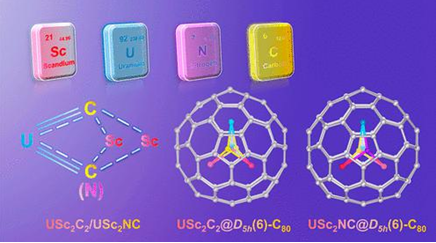USc2C2 and USc2NC Clusters with U−C Triple Bond Character Stabilized Inside Fullerene Cages
Hongjie Jiang 1⊥ , Xiaojuan Yu 2⊥ , Min Guo 1⊥, Yang-Rong Yao 1 , Qingyu Meng 1 , Luis Echegoyen 3 , Jochen Autschbach 2* , Ning Chen 1*(谌宁)
1 College of Chemistry, Chemical Engineering and Materials Science, and State Key Laboratory of Radiation Medicine and Protection, Soochow University, Suzhou, Jiangsu 215123, P. R. China.
2 Department of Chemistry, University at Buffalo, State University of New York, Natural Sciences Complex, Buffalo, New York 14260-3000, United States.
3 Department of Chemistry, University of Texas at El Paso, 500 West University Avenue, El Paso, Texas 79968, United States.
⊥H.J., X.Y., and M.G. contributed equally to this work.
J. Am. Chem. Soc. 2023, 145, 5645--5654
The chemistry of f-block metal–carbon multiple bonds is underdeveloped compared to well-established carbene complexes of the d-block transition metals. Herein, we report two new actinide-rare earth mixed metal carbides and nitrogen carbide cluster fullerenes, USc2C2@D5h(6)-C80 and USc2NC@D5h(6)-C80, which contain U–C bonds with triple bond character and were successfully synthesized and characterized by mass spectrometry, UV–vis–NIR spectroscopy, Fourier transform infrared spectroscopy, single crystal X-ray diffraction, and DFT calculations. Crystallographic studies show that the two previously unreported clusters, USc2C2 and USc2NC, are stabilized in the D5h(6)-C80 carbon cage and adopt unique trifoliate configurations, in which C2/NC units are almost vertically inserted into the plane defined by the U and two Sc atoms. Combined experimental and theoretical studies further reveal the bonding structure of USc2C2 and USc2NC, which contain C═U(VI)═C and C═U(V)═N bonding motifs. The electronic structures of the two compounds are determined as U6+(Sc2)6+(C4–)2@D5h(6)-C804– and U5+(Sc2)6+(N)3–(C)4–@D5h(6)-C804–, respectively. Quantum-chemical studies confirm that the U–C bonds in both molecules show unprecedented multicenter triple-bond character. The discovery of this unique U–C multiple bond offers a deeper understanding of the fundamentals of uranium chemistry.

链接://pubs.acs.org/doi/full/10.1021/jacs.2c10231